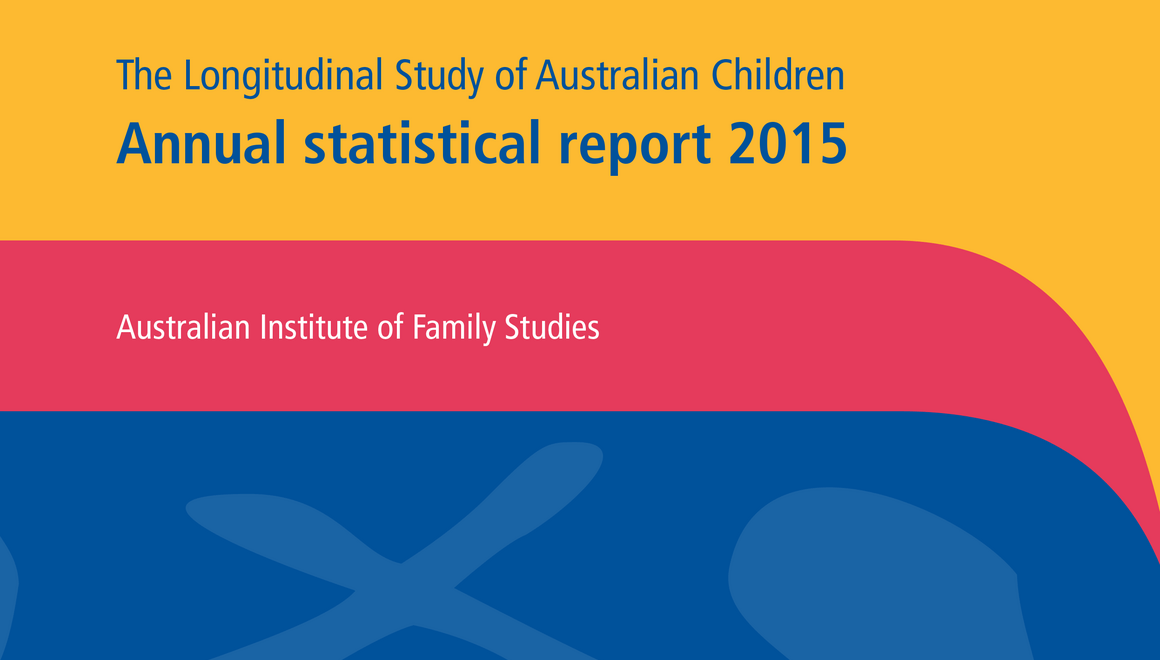Annual statistical report 2015
Annual statistical report 2015

Growing Up in Australia: The Longitudinal Study of Australian Children (LSAC) is Australia's first nationally representative longitudinal study of child development.
The purpose of the study is to inform research into the development and life-course trajectories of Australian children and young people.
The longitudinal nature of the study (involving repeated observations over time) enables researchers to examine the dynamics of change through children’s lives, thereby giving policy-makers and researchers access to quality data about child development in contemporary Australia.
This is the sixth volume in the LSAC Annual Statistical Report series, which uses data from the first five waves of the study. The purpose of the annual reports is to provide a snapshot of some of the data from the LSAC study, in order to address policy-relevant questions about Australian children and their families. The reports describe the dynamics of change as children develop, looking at how they—and their families—change through time.
Contents
Study purpose and design, and 2015 report analyses.
2. Grandparents in their young grandchildren’s lives
Jennifer Baxter and Diana Warren
Grandparents provide childcare and important housing and financial support to their families, particularly during their grandchildren’s early years. This chapter uses LSAC to explore different ways that grandparents are involved in the lives of their grandchildren, capturing involvement from ages 0–1 years through to 12–13 years.
Media release: Grandparents provide support through the ages
3. Diversity, complexity and change in children’s households
Jennifer Baxter
“Complex” households are simply non-traditional households, where children may live with a single parent; a non-biological parent; step or half-siblings (i.e., “blended” families); or a grandparent. Over 40%—or two in five—of 13 year-old children had experienced some form of family complexity while growing up. The most common form is families with a single parent or with a non-biological parent. This chapter explores children’s experiences of household complexity and asks how that experience changes as children grow. It also looks at the stability of complex household relationships and analyses what bearing parental characteristics have on household complexity.
Media release: Two in five children live in a complex family
4. Demographic, attitudinal and psychosocial factors associated with childhood immunisation
Jacqueline Homel and Ben Edwards
In June 2014 over 90% of Australian children were fully immunised at the milestone ages of 12, 24 and 60 months. These excellent levels of coverage must be improved and maintained over time. To achieve this, it is important to identify which potentially modifiable factors are related to incomplete immunisation. This chapter uses LSAC data linked to the Australian Childhood Immunisation Register to examine the demographic, psychosocial and attitudinal factors related to incomplete immunisation at 12, 24 and 60 months.
5. Australian children’s screen time and participation in extracurricular activities
Maggie Yu and Jennifer Baxter
A majority of Australian children are spending more than the recommended two-hour daily limit for screen time (watching television, on computers and playing electronic games). LSAC data show that by 12–13 years of age, children are averaging more than three hours screen time per week-day and almost four hours per weekend day. This means that up to 30% of a child’s waking time is spent in front of a screen. This chapter explores how much time children of various ages are spending on screen-based activities, how the amount of screen time varies across children from different families, and whether time spent on these activities is related to children’s time spent on other activities.
Media release: Australian children spending more time on screens
6. Pubertal status and emotional, school and social functioning
Diana Warren and Maggie Yu
The onset of puberty marks the transition from childhood to adolescence, involving rapid physical growth, and physical, emotional and cognitive changes. A better understanding of the factors associated with the timing of the onset of puberty is not only important for understanding patterns of physical development, but it also has important clinical, health and educational implications. This chapter examines factors that may be associated with children’s pubertal timing, including household structure and the pubertal timing of parents. It then explores the association between pubertal status and children’s emotional functioning, school functioning and relationships with peers.
7. Parents’ choices of primary school
Diana Warren
Australian parents decide which primary school is best for their child based firstly on convenience and secondly on a host of largely personal factors, which often go beyond academic outcomes. This chapter examines the main factors associated with parents’ decisions about the type of primary school their child will attend, asking:
- Does parents’ choice of primary school sector differ according to characteristics such as the parents’ education and household income?
- Do parents’ reasons for changing schools differ according to characteristics of the child and the household?
- How do other aspects of school quality influence parents’ choice of school?










